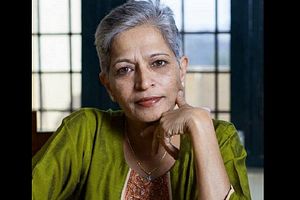October 5 marks one month since journalist and activist Gauri Lankesh was murdered outside her house in the cosmopolitan city of Bengaluru in India. Her death at close range, by assailants who came on a motorbike, has shaken the civil society, prompting protest demonstrations across the country. These protests challenge the increasing audacity with which anyone questioning the current nationalistic establishment – one that denounces secularism and calls for a Hindu statehood – is deemed an “anti-national” by supporters of the ruling Bharatiya Janata Party (BJP) and Prime Minister Narendra Modi, who has been mum about these killings.
Apart from investigative journalism exposing criminal activities of a BJP politician, Lankesh was widely critical of the current government’s pro-Hindu, anti-Muslim stance. The Rashtriya Swayamsevak Sangh (RSS), which is the ideological base of BJP, had called for a ban on cow slaughter. In 2015, Mohammad Akhlaq and his son Danish were dragged out of their home in northern India, following rumors that they had slaughtered a cow. Akhlaq succumbed to his injuries. Forensic reports by two separate agencies differed on the test results of the meat found in their fridge. Bovine-related violence on Muslims increased after Modi came to power in 2014.
Lankesh’s independent publication Gauri Lankesh Patrike in the Kannada language was able to reach out to a far larger audience in the state of Karnataka than English media could, and hence her journalism was seen as a thorn for a government that has been quick to muffle free speech.
September alone saw the murder of three journalists, including Lankesh, across different parts of India. The CPJ reports that between 1992 and 2016, 27 journalists were murdered in India. Most of those killed worked in non-English media, and made local politicians and industrialists uncomfortable. Cartoonist Irfan Hussain was murdered in March 1999 for his cartoons depicting the rise of Hindu extremists. In 2002, Ramchandra Chhatrapati had published an anonymous letter accusing self-proclaimed cult leader Gurmeet Ram Rahim Singh – jailed recently – of rape. Chhatrapati was shot and killed weeks after his story ran. Freelance journalist Jagendra Singh was doused in petrol and set on fire in 2015 for having written about the illegal activities of a politician of the ruling Samajwadi Party in the state of Uttar Pradesh.
Freelance journalist Malini Subramaniam was hounded out of Bastar in the central Indian state of Chhatisgarh by a vigilante group which worked in connivance with the local police. Her reports about attacks on the indigenous population challenged the government’s narrative of a Maoist counterinsurgency.
Journalist Nikhil Wagle in Mumbai, India’s commercial capital, has received innumerable threats for challenging ultra-consevative groups like the Sanatan Sanstha, and Shiv Sena, the right-wing and often-extremist political party which governs the municipal body in Mumbai.
But Lankesh’s murder is also alarming because this was perhaps the first time that a journalist was killed based on a political ideology and not merely because of investigative reporting. Fittingly, her murder has made journalists in the mainstream media uncomfortable. Soon after her murder, some journalists received threats that they would face similar fate if they continued to challenge Prime Minister Modi, the BJP or the RSS, or if they were “traitors like Muslims.” One such journalist is the popular TV journalist Ravish Kumar of the Hindi news channel NDTV 24×7, and he recently penned an open letter addressed to Modi, asking if he should also fear for his life. An investigation by Alt News revealed that one of the persons attacking Kumar online is followed on Twitter by Modi’s official Twitter account.
While trolls on Twitter might seem physically distant, their threats perhaps cannot be shrugged off. There has been a rise of fake news websites whose allegiances are with the Hindutva ideology of the ruling party. Lankesh had been receiving threats for a while – online and otherwise. In November 2016, Lankesh was convicted in two separate defamation cases for her article from January 2008 criticizing leaders from BJP. She was out on bail. In an interview to Newslaundry after her conviction, she said that “Modi Bhakts [devotees] and the Hindutva Brigade” are “keen to somehow shut me up.”
It’s far worse when the journalist is a woman, questioning the dominant narrative of development, secularism and corruption in India. Her gender becomes the first frontier of attack. Any location in India can be a potential danger zone for a woman journalist; in August this year, a woman journalist was heckled by men at a university campus while she was interviewing other women. Almost all of India’s intrepid female journalists have been at the receiving end of excessive online harassment, no matter how political their work might be.
The call for a law to protect journalists has also had some opponents from among journalists: a lively, bold and free media is the keystone to democracy and hence, laws towards ensuring safety of journalists is indicative of lapses towards upholding democratic principles.
Even as the Indian media landscape is dominated by corporate motives, such that vested interests compromise journalism, journalists being seen as dissenters opens the door to a possibly united effort towards combating this silencing of journalism and free speech. Too many journalists – several of them freelancers, without the security blanket of insurance, security training, decent pay, work contracts – have taken the bullet for doing their job. Perhaps the murder of Gauri Lankesh will galvanize the country’s journalists to band together to continue to dissent, and stand up to the silencing of critiques, sponsored through the silence of Modi as his supporters unleash terror on anyone who questions him.

































